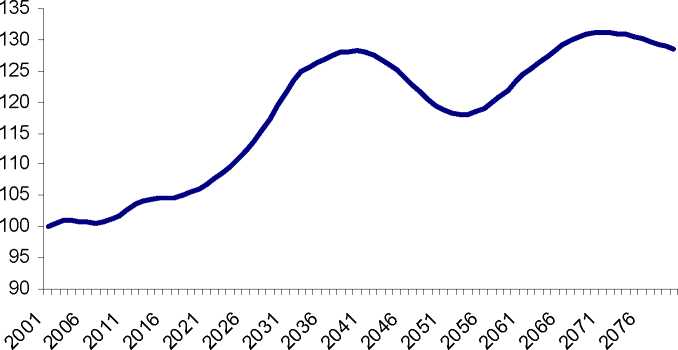changed welfare arrangements and mode of financing via various forms of tax-
ation. The basic question is thus whether these policies can be sustained, i.e.
are they consistent with fiscal sustainability.
4.3 The demographic projection
Demographic projections depend on future fertility, mortality and migration.
The uncertainty associated with the projection of each of these determinants is
significant, and the evolution of the total population becomes highly uncertain
in longer run projections. However, what really matters in relation to fiscal sus-
tainability is the robustness of the demographic dependency ratio with respect
to changes in the underlying population flows. The analysis is based on the
demographic forecast of the Welfare Commission (2004).
Using the methods suggested by Lee and Carter (1992), Haldrup (2004)
estimates age and gender specific mortality rates for Denmark using data from
1900-2002. These estimates imply that the average annual future growth rates
in life expectancy are in the range from 0.08 to 0.09 years for both men and
women. However, these estimates are cautious and imply that the growth rate in
life expectancy remains approximately half of that projected for Western Europe
over the next 50 years (United Nations, 2004). In any case, this suggests that
uncertainty with respect to life expectancy may be significant.
Figure 1: Demographic dependency ratio
2001=100

Note: Persons age group below 15 and above 64 as a fraction of age group between
age 15 and 64.
Source: Velfærdskommissionen (2004)
The projection shows a fall in the size of the population (from 5.4 million
13
More intriguing information
1. The name is absent2. Cultural Diversity and Human Rights: a propos of a minority educational reform
3. The name is absent
4. The Role of Land Retirement Programs for Management of Water Resources
5. Gerontocracy in Motion? – European Cross-Country Evidence on the Labor Market Consequences of Population Ageing
6. Urban Green Space Policies: Performance and Success Conditions in European Cities
7. The name is absent
8. The name is absent
9. MULTIPLE COMPARISONS WITH THE BEST: BAYESIAN PRECISION MEASURES OF EFFICIENCY RANKINGS
10. The name is absent